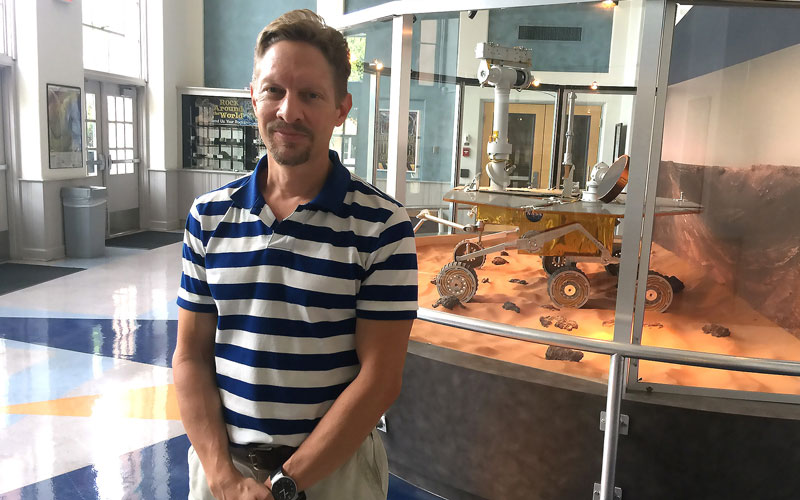
Steve Ruff, associate research professor at Arizona State University’s School of Earth & Space Exploration, says the discovery of what appears to be briny water on the surface of Mars will advance knowledge of the Red Planet. (Photo by Jesse Millard/Cronkite News)
This week’s landmark announcement that the surface of Mars has liquid water links back to a University of Arizona laboratory where students and faculty monitor images from an orbiting camera.
Read more:
In 2010, Lujendra Ojha, then an undergraduate working in the Lunar and Planetary Laboratory, spotted dark streaks flowing down some of Mars’ slopes during the warm season. The images were taken by UA’s High Resolution Imaging Science Experiment (HiRISE) aboard the Mars Reconnaissance Orbiter.
HiRISE has been called the most powerful camera ever sent to another planet.
“No other camera can see or detect the (streaks) on the surface of Mars. And for HiRISE to have a continual presence on the Martian surface, it helps us quantify the behavior,” Matt Chojnacki, a UA research staff scientist, said after Monday’s announcement.
Ojha, now a doctoral student at Georgia Institute of Technology, continued his research with NASA to confirm that the streaks, referred to as Recurring Slope Lineae, consisted of liquid briny water.
On Wednesday, Gov. Doug Ducey issued a special recognition congratulating Ojha.
“It isn’t every day that evidence of flowing water is found on another planet, and I’m proud this significant discovery was made right here in Arizona,” the governor’s statement read.
HiRISE left for Mars in 2005 and is past its warranty date, Chojnacki said.
At the Mars Space Flight Facility to talk about liquid water on the red planet’s surface. @cronkitenews pic.twitter.com/YNSIkj3My4
— Jesse Millard (@Jesse_Millard) September 28, 2015
“This highlights we are still doing important research and worthy of continued funding,” he said.
An orbiting spectrometer, an apparatus that analyzes light wavelengths to determine mineral composition, was used to confirm the presence of water.
Ojha’s discovery has Arizona State University’s Mars Space Flight Facility analyzing the mineral composition of slopes where the dark streaks occur. ASU has its own spectrometer, THEMIS, in Mars orbit.
Some data relayed by THEMIS has found that the slopes don’t hold much liquid water, said Steve Ruff, associate research professor at the Mars Space Flight Facility.
“So these (streaks) can be thought of really as just damp soil more than some kind of gushing spring,” he said.
Ruff said Monday’s announcement shows that water remains part of Mars’ environment.
“Today’s discovery really highlights that Mars can have a water cycle today,” he said.